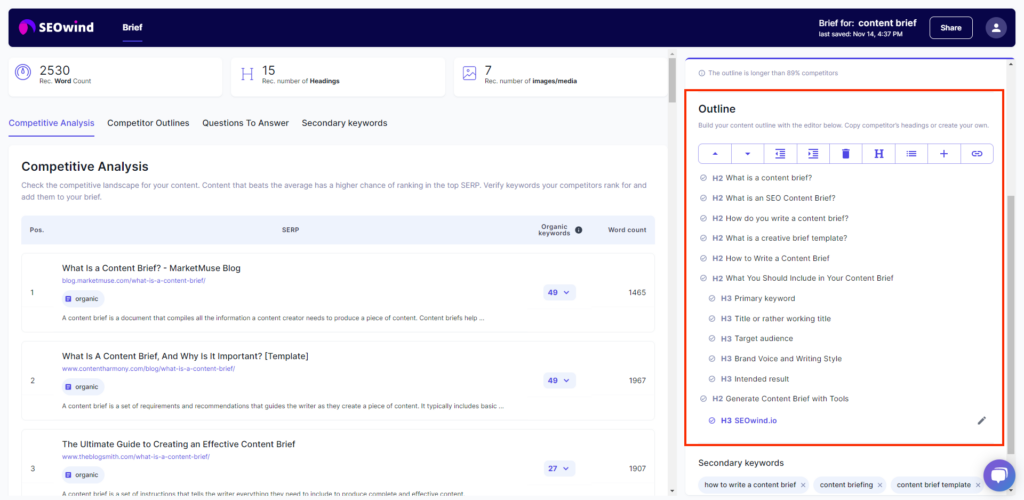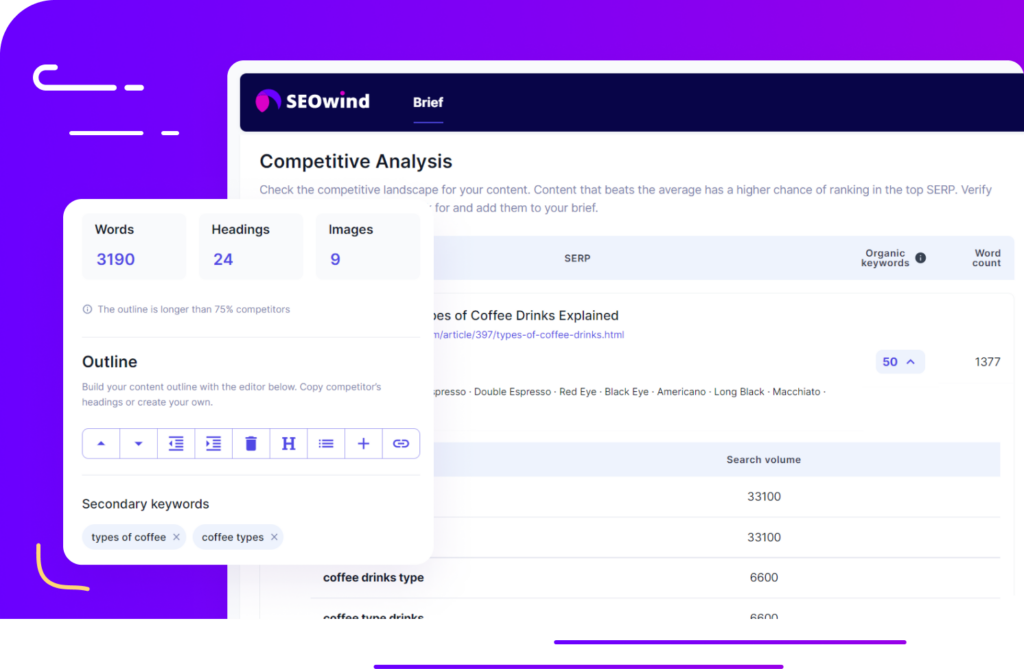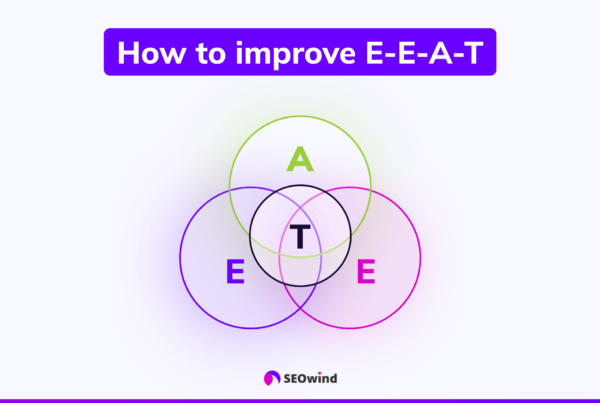Crafting long-form content pieces may not be a direct factor in boosting website rankings, but that doesn’t mean it’s time to discard them altogether. Long-form content reveals the depth of knowledge on your chosen subject and can go a long way in positioning yourself as a reliable source of information – all resulting in driving more traffic to your website. What’s more, the data on best-performing long articles shows that Google still likes that kind of content.
So if you want to establish yourself amongst credible influencers, start writing!
TL;DR
- Long-form content reveals the depth of knowledge on your chosen subject and can go a long way in positioning yourself as a reliable source of information, driving more traffic to your website.
- Long-form content is often perceived as more reliable, research-based content than short-form content.
- Long-form content is not always as long as you may think, with 1000 words as the standard to qualify as a long-form article.
- Long-form articles work because they bring value and information to your website’s visitors, which is what you want to achieve.
- Long-form content is suitable if you have something to say and it is not repetitive or copying other people’s website content.
- Longer-form content tends to perform the best, but not every post or article needs to be more than 2,000 words.
- The ideal length for a blog post for SEO purposes is 2,100-2,400 words, and for lead generation is 2,500 words.
- The ideal length for pillar pages is around 4,000 words, while listicles or list blog posts should be 2,300-2,600 words.
- How-to blog posts should be between 1,700 and 2,100 words.
- Long-form content is beneficial in driving more traffic to your website, establishing yourself among credible influencers, and improving your website’s ranking.
What Is Long-Form Content and Why Does it Work?
Actually, long-form content is not always as long as you may think. The standard to qualify as a long-form article is only 1000 words. If you are knowledgeable about your niche’s topics, then those can be written in about 1 hour or less.
But any amount of words over 1000 qualify as a long-form article. If you are feeling up to it, you can write a blog or other website content of 2000+ words. Whether you are a writer or not, having these longer articles or posts on your website does help its ranking.
Even though there are experts out there saying that a website visitor’s attention only lasts about 10 to 20 seconds, long-form articles work because they bring value and information to your website’s visitors. That is what you want to achieve.

How to Know If You Should Use Long-Form Content
One of the ways you know if you should use the long article format is if you have something to say and it is not repetitive or copying other people’s website content. Just writing a long article for the sake of writing a long article does not work.
Long-Form Vs. Short-Form Content
| Category | Long-form article | Short form article |
| Word count | 1000+ words | 100 to 999 words |
| Topic content | More detailed, informative | Either general or very up to the point |
| Topic coverage | In-depth, fully researched | An overview, hitting the high points |
| Perception | Often perceived as a more reliable, more research-based content | Often perceived as a simple explanation or statement |
| Writing | Gives you lots of space to say what you want or need to say | Up to the point and concise |
| Workload | Usually, more time consuming | Usually, less time consuming |
| Target purpose | To educate visitors | Grab visitors’ attention |
| Use cases – user intent | Searching for an answer to a question on Google Looking for a guide to a complex strategy or product | Looking to make a quick, inexpensive purchase Previous customers who you want to return Reading an email from you |
| Typical examples of content | Ebooks White papers Long-form blog posts Reports Case studies | Social posts Email newsletters Infographics Short videos News articles |
How long should long-form content be?
There is no clear definition of how long should long-form content be and what is the average long-form content length.
While longer-form content tends to perform the best, that’s not to say that every single post, article, or page you publish must be more than 2,000 words. If you feel you’ve covered your topic well enough in 300, 800, or 1,000 words, then it might be enough.
The average long-form content length
It seems that all depends on the goal the long-form content is intended to achieve. Let’s look at the data.
HubSpot analyzed their top-performing blog posts and here is what they found (HubSpot, 2020):
- The ideal length for a blog post for SEO purposes
- The ideal blog post length for SEO purposes is 2,100-2,400 words.
- The average length of the 50 most-read blog posts was 2,330 words.
- Individual blog post lengths ranged from 333 to 5,581 words, with a median length of 2,164 words.
- Still, not all blog posts need to be super long – 16 of 50 top-read posts (so about one-third) were under 1,500 words.
It is also confirmed by SEMrush research. Articles over 3,000 words get 138% more traffic than those with fewer than 500 words (SEMrush, 2022)
- The ideal length for a blog post for lead generation
- The ideal length of a blog post intended to generate leads is 2,500 words
- The 50 posts that generated the most leads in 2019 were an average of 2,569 words long and had a median length of 2,529 words, which is approximately 250 and 400 words longer than the average and median lengths of the most-read blog posts.
- The ideal length for the content pillar
- Pillar pages should be around 4,000 words.
- Most read pillar pages had an average of 4,048 words and a median length of 3,639 words.
- Word lengths for these pillar pages ranged from 2,137 to 10,939 words.
- The ideal length for listicles length
- Listicles, or list blog posts, should be 2,300-2,600 words.
- HubSpot’s most-read listicles in 2019 were an average of 2,574 words and had a median length of 2,332 words.
- They ranged between 1,040 and 5,581 words in length
- The ideal length for “How-to” blog posts
- How-to blog posts should be between 1,700 and 2,100 words.
- Top-read how-to blog posts, we saw an average length of 2,151 words and a median of 1,669 words.
- The ideal length for “what is” blog posts
- “What is” blog posts should be between 1,300 and 1,700 words
- The most-read “what is” posts are less than 1,000 words.
Types Of Long Form Content
While most people define long-form articles by written content, it is not the only format that qualifies as a long article. Other content that qualifies is:
- Videos
- Social media posts
- How-to guides
- Images

Why Long-Form Content Helps SEO
In a nutshell, long articles help your SEO in the following ways:
- It’s copy-rich and easy for Google to crawl and understand
- You can target a range of keywords and drive organic traffic
- Build authority and credibility
- Add value to a website as a whole
- Generate links and brand awareness
- Long-form content can be evergreen and regularly updated
- Long-Form Content Can Increase Conversion Rates
All of these points are pointing you to several key facts about writing a long article.
The first fact is that you have more versatility. You can include a lot of content that is vital to your business, share your expertise, and provide the reader with examples.
Second, you have the opportunity to use different keywords to generate traffic as well as being able to keep your content updated.
Third, you have a variety of options to create your content.
This keeps your content interesting and helps build your reputation and ultimately convinces people to buy your products or services. All of these aspects combine together to help you reach your objective and business goals.

Tips and Tricks on Writing Quality Long-Form Content
Writing long-form content can be an intimidating process, but it doesn’t have to be. Whether you’re writing for an audience of hundreds, thousands, or millions – long-form content is essential for engaging your readers. To help you get started, here are some top tips and tricks that professionals use when creating quality long-form content.
Choose the core topics you want to write about
You cannot write unless you know what you want to talk about. One of the first steps is deciding which topic you know and want to share with your audience. This will give you credibility.
Then think about which topics will resonate with your target audience. You may write well, but if your audience is not interested in what you’re sharing it doesn’t make sense to focus on that. Always think about not only what is easy for you to write about but also what really bothers and interests your potential customers.
Third, decide which point of view you wish to be known for. What you write will build your reputation, good or bad.
Finally, take time to plan the structure of your long article and see which pieces, videos, content, etc., fit where and how long each should be.
Do the proper keyword research
Keyword research is always a vital step when you are trying to rank as well as draw traffic to your website. There are various ways and tools to find the right keywords.
One of the basic ones is to pick your topic and then search for the top-ranking websites. Next, you take those URLs and verify what keywords they rank for using tools like SEMrush, ahrefs, or SEOwind. You can also plug them into a content gap tool and see all the keywords your competitors are covering and you’re not yet.
Target Long Tail Keywords
Do not omit these. These long-tailed keywords are very specific and help you attract the attention of users who are specifically looking for content on the topic you are writing about. They usually have lower search volume and keyword difficulty as well. But you can rank much easier than for shorter, more general keywords.
Often they represent the mid and bottom funnel which means they are more niche or more connected with your services or products.
Do your research
Not just with keywords and other SEO strategies but with your topic or niche.
Don’t forget to see what is already out there so you can structure your content in a more compelling manner. Check what already ranks, what topics and questions others covered on their pages, and come up with something extra.
Decide how long your content should be
You made the decision that it will be long form. How long will it be? Set the maximum word count goal.
If you are still struggling with how long it should be, just check the SERP and their word count. It will give you a direction on how long your content should be.
Pick a content format
See what kind of formats are ranking and follow that success. There is always room for similar formats, but there is no room for plagiarized material. You can use any of the following formats to present your material in the best possible way:
- Guides
- Listicles
- How-tos
- Tutorials
- Reviews
- Definitions
- “Vs” posts
- And more
When choosing a format think about what kind of format will be the best to convey your message.
Create a content outline
When creating long-form content it is important to have your thoughts and topics structured. Usually, it takes the form of a content outline where you list:
- headings and subheadings,
- key takeaways,
- keywords to target.
If you're writing a blog post outline, we've prepared detailed steps, tips, and templates in the following article: How to Write a Blog Post Outline [Steps, Tips and Templates].
Having a clear structure before you start writing will ensure your content is easy for the reader to follow.

Use content tools
AI content writing tools like SEOwind can be of great help with the research we’re talking about. The standard process requires a lot of manual work, analyzing SERPs, opening them in a separate tab, looking through their content, and verifying keywords. With SEOwind you can speed up the process a lot. You type in your keyword and you will get all the analysis done for you. From one place you can make decisions regarding secondary keywords, topics to cover, headings and subheadings, along with questions people ask. This cuts the whole process to minutes, instead of hours.

Assess Your Resources
Do you have the expertise to cover the topic? If not then check with your team whether you have the knowledge, expertise, and skills to write about a particular topic. You need to assess your strong and weak points and be honest about your abilities. Readers can easily notice when you try to write on a topic you know nothing or little about.
If it turns out that you don’t have competencies on the topic, cover the basics and fill in the gaps with the industry expert. This will make your content more reliable.
Start writing
Now that you have your outline and sub-headings and identified keywords you would like to rank for, it is time to start writing and filling in the content. There are different methods to do your writing: you can either do it on your own or use AI tools to support you. If you happen to generate AI content be reasonable as it is not what Google likes. Still, using them in a smart way can speed up your writing and make it even more engaging.
Use short paragraphs
Once you pick the method, write in short paragraphs. Those provide a higher readability score than long, drawn-out paragraphs. They are much easier to read and follow by your audience.
The hook matters
Then when you start writing, you need to create a great hook that will keep your website’s visitors’ attention and keep them reading. Make them intrigued about what you want to share.
Use appropriate style
Make sure to write in a conversational and friendly style. Each brand has its own tone of voice and style. Always reflect them in your writing style.
Add images and graphics
To make your content easier and more interesting to read, do not forget to break up the written content with images and infographics. Especially if you are writing on a complicated topic.
For more content writing tips go to the following article: SEO Content Writing Tips. How to Write SEO content like a PRO
Mix long with short content
It would be easy to fall into this mistake. Making all your web pages long-form articles may be easy, but it is overkill. Learn to mix it up and put in shorter articles when the topic calls for shorter articles.
Trying to stretch a topic out, so you meet a long article word count is going to ruin the quality of your article. If you are highlighting a specific video, you do not need to write a book explaining the content of the video. Here is where ‘less is more’ applies.
Be discerning and only write what you need to write on any given topic, whether long or short. Don’t stretch it if it is not needed.
Make your long content easy to read
From time to time you will hear that website visitors do not have time to read long articles or that their attention spans are only 20 seconds long. But that doesn’t have to apply when you’re writing long content.
You can make it an easy read by adding a table of contents, short paragraphs with subheadings, using bullet points, or using a summary at the beginning of the article so people can bookmark it for later when they have more time.
Plus, you can use images or memes to break up the monotony. All of these options help make a long-form article easier and faster to read.
Use listicles
Not everyone has the talent to write long-form articles the standard way. They need a little help to get the content above that 1000-word mark. That is okay, as not everyone likes to write or has a lot to say.
But if you need to add some long-form articles to your website’s lineup, then use a listicle. These little lists make it a lot easier to fill in the content to meet that longer word count.
Plus, the content will be easier to read and be user-friendly to those buys people who like reading your blog, etc.
Some Final Words
When you are writing for your website, keep in mind that one method or length is not the only way to get great content. Long-form articles are a great way to get you to be seen as an authority and as a credible source of information.
Don’t omit this format because it takes a lot of time and effort. These long articles provide you with more versatile writing options than short ones do. Plus, Google and users like the information they get from them.
Mixing up your website’s content length is a great way to keep people interested in what you have to say. Besides, not every topic needs 1000 or 3000 words to be valuable or informative.


